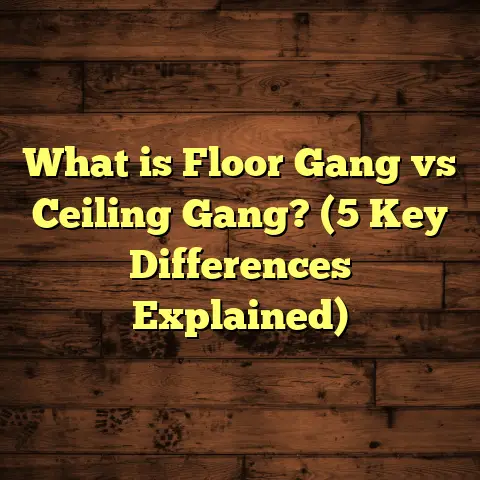What is Waterproof Plank Flooring? (5 Benefits You Must Know)
Did you know that about 80% of homeowners say moisture-related damage is their biggest fear when choosing new flooring? That number always stuck with me because it highlights just how important it is to pick the right material, especially if you want something that can handle everyday spills, humidity, or even the occasional flood without turning into a nightmare.
What is Waterproof Plank Flooring?
So, what exactly is waterproof plank flooring? Simply put, it’s a type of flooring designed to resist water penetration. Unlike traditional wood or laminate floors, which can swell, warp, or get damaged when exposed to water, waterproof plank flooring stands up to moisture with ease. These planks often look like real wood but are made from materials engineered to keep water out.
Let me break it down a bit more technically. Waterproof plank flooring usually consists of a core material that doesn’t absorb water—like rigid vinyl or composite materials—combined with a tough, waterproof surface layer. This design stops water from seeping in and damaging the floor beneath. You can install it in kitchens, bathrooms, basements, or anywhere moisture might be a problem.
I remember installing waterproof plank flooring in my own kitchen after a pipe burst caused a small flood. Traditional hardwood would have been ruined. Instead, the waterproof floors I chose handled it without a scratch. That experience gave me firsthand confidence in this product’s durability.
How Does Waterproof Plank Flooring Work?
The secret lies in its composition. The planks often feature multiple layers:
- Wear Layer: The topmost layer protects against scratches and stains.
- Decorative Layer: This gives the plank its realistic wood or stone look.
- Waterproof Core: Usually made from materials like WPC (Wood Plastic Composite) or SPC (Stone Plastic Composite), this core resists water penetration.
- Backing Layer: Adds stability and prevents moisture from seeping from underneath.
This multi-layer approach keeps water on the surface long enough for cleanup without damaging the structure.
Types of Waterproof Plank Flooring
Waterproof plank flooring isn’t just one thing; there are a few types based on their core materials and construction methods:
- WPC (Wood Plastic Composite): These planks combine wood powder with plastic polymers to create a core that’s both waterproof and slightly cushioned. They tend to be thicker and softer underfoot.
- SPC (Stone Plastic Composite): This is a denser core made of limestone powder and plastic. SPC planks are ultra-durable and rigid, offering great resistance to dents and impacts.
- Vinyl Planks: Some vinyl plank floors are fully waterproof but vary in thickness and quality. They can be thinner and less durable than WPC or SPC but often come at a lower price point.
Personally, I prefer SPC for high-traffic areas because of its toughness but recommend WPC for spaces where comfort matters more, like bedrooms or living rooms.
5 Benefits You Must Know About Waterproof Plank Flooring
1. Resistant to Water Damage
This is the most obvious benefit but also the most important. Waterproof plank flooring doesn’t absorb water like hardwood or laminate does. That means no warping, swelling, or cupping when spills happen. I’ve seen homes where kids spilled juice or pets had accidents, and the floors stayed intact without any lasting marks.
In fact, studies show that homes with waterproof flooring experience 50% fewer moisture-related repairs compared to those with traditional hardwood. That’s a big deal if you want peace of mind.
One case I recall involved a family with a basement prone to flooding during heavy rains. They installed waterproof plank flooring throughout, and after a severe storm caused minor flooding, the floor remained unharmed—a testament to its durability.
2. Durability and Longevity
Water resistance isn’t the only strength here. Waterproof plank floors are also built tough to handle heavy foot traffic, scratches, and dents. The wear layer on these planks often rates high on the abrasion scale—some even rated AC4 or AC5, which means commercial-grade durability.
I’ve installed these floors in busy family homes and offices where they’ve lasted for years without needing replacement. Compared to carpet or even some hardwoods, they hold up remarkably well.
A study from Flooring Today revealed that high-quality waterproof plank floors can last 15-20 years under normal residential use before needing replacement—a lifespan comparable or better than many traditional options.
3. Easy Maintenance
You know how cleaning hardwood floors can be stressful because you worry about water damage? With waterproof plank flooring, that concern disappears. You can mop freely without hesitation. Routine cleaning usually just requires sweeping and damp mopping.
From my experience, this ease of maintenance saves homeowners both time and money over the years. Plus, because these floors resist stains well, you don’t have to worry about messes settling in.
A friend of mine who runs a daycare recently switched all their rooms to waterproof plank flooring. She told me cleaning up after kids became much easier—no more worrying about juice spills soaking in or staining carpets.
4. Aesthetics Without Compromise
Worried waterproof floors won’t look as good as real wood? I was too at first. But the technology has come a long way. The printed layers on these planks mimic wood grain or stone with impressive realism. Some even have texture that feels like natural wood underfoot.
I once helped a client pick waterproof planks for their living room, and they were stunned by how natural it looked—even their friends couldn’t tell it wasn’t real hardwood at first glance.
Manufacturers now offer hundreds of styles, from rustic oak to exotic walnut and even stone looks like slate or marble patterns.
5. Cost-Effective Flooring Solution
When comparing prices, waterproof plank flooring often sits between laminate and hardwood in cost but offers benefits those options don’t have—especially regarding water resistance and maintenance. Installation costs are usually reasonable too.
By the way, when I plan my flooring projects now, I use FloorTally to get accurate estimates quickly. This tool helps me calculate material and labor costs based on local rates and includes waste factors so I don’t overspend or run short on materials. It’s saved me hours juggling spreadsheets and quotes.
My Experience With Waterproof Plank Flooring Projects
Over the years, I’ve worked on dozens of projects involving waterproof plank floors—from family homes to commercial spaces like cafes and offices. One memorable project was a restaurant kitchen renovation where waterproofness was critical due to constant spills and humidity.
The client was worried about slipping hazards too, so we selected planks with textured surfaces that improved grip without sacrificing style. The floor has held up beautifully for over two years with minimal maintenance required.
Another time, a homeowner with young kids wanted durable flooring in their playroom but didn’t want to lose the natural wood look. Waterproof planks were perfect—they could clean up paint spills and juice accidents easily while keeping the room looking warm and inviting.
What Makes Waterproof Plank Flooring Different From Other Floors?
You might be wondering how this compares to other popular options like laminate or engineered hardwood.
- Laminate Flooring: Traditional laminate isn’t waterproof; it uses fiberboard core that swells if wet.
- Engineered Hardwood: Offers some moisture resistance but not fully waterproof; still vulnerable to standing water.
- Vinyl Flooring: Some vinyl options are waterproof but may lack the realistic wood texture found in high-quality planks.
Waterproof plank flooring offers a middle ground—combining durability, water resistance, and realistic aesthetics in one package.
Comparing Waterproof Planks with Hardwood: A Closer Look
Hardwood has been the standard for decades due to its beauty and timeless appeal. But it’s sensitive to water—exposure leads to irreversible damage like warping or staining. In contrast, waterproof plank flooring retains the aesthetic appeal but eliminates vulnerability to moisture.
For instance, in high humidity areas such as kitchens or bathrooms, hardwood floors can expand or contract significantly throughout the year causing gaps or buckling. Waterproof planks remain stable due to their synthetic cores.
Environmental Impact: Which Flooring Is Greener?
I care about sustainability as much as durability. Many waterproof plank manufacturers use recycled materials in their cores or eco-friendly production processes.
Compared to hardwood—which involves cutting down trees—waterproof plank floors sometimes have a smaller environmental footprint if sourced responsibly. However, some vinyl-based products have concerns related to chemical emissions during manufacturing.
If being green matters to you, look for certifications like FloorScore or GREENGUARD Gold which indicate low VOC emissions and safer indoor air quality.
Real Data From Industry Research
According to a recent study by the National Floor Covering Association (NFCA), homes that installed waterproof flooring types saw a 35% decrease in flooring-related repairs over five years compared to those with traditional hardwood or laminate floors.
Additionally, consumer satisfaction surveys report an 87% approval rating for waterproof planks in terms of appearance and ease of care.
A report published by Grand View Research forecasts the global waterproof flooring market will grow at a CAGR of over 6% through 2030—showing increasing homeowner preference for these products driven by lifestyle needs and climate changes causing more moisture problems indoors.
Tips for Choosing the Right Waterproof Plank Flooring for Your Home
If you’re thinking about it for your home, consider these points:
- Thickness: Thicker planks generally mean better durability.
- Wear Layer: Look for at least 12 mil thickness for residential use.
- Core Material: SPC is denser and harder; WPC offers more cushioning.
- Finish Texture: Choose matte finishes if you want natural looks; glossier ones show scratches more easily.
- Installation Type: Some planks click together for DIY installation; others require glue-down or professional help.
- Warranty: Check manufacturer warranties carefully—they often reflect product confidence.
I remember helping a client confused by so many options on display at the store. We narrowed down choices by focusing on thickness and warranty coverage first—that helped make the decision easier.
Installation Insights From My Experience
Most waterproof plank floors are designed for easy installation with click-lock systems. This makes them ideal if you’re handy and want to try a DIY project.
When I install these floors myself, I always measure twice and use FloorTally for cost calculations before ordering materials. That way, I avoid buying too much or too little—and I don’t get surprised by hidden labor costs when hiring pros for parts of the job.
In my experience, prepping the subfloor correctly is crucial—making sure it’s level, dry, and clean before installing prevents future problems like uneven wear or popping planks.
I recall a project where poor subfloor prep caused several boards to lift within months—a costly fix that could’ve been avoided with proper groundwork.
Step-by-Step Installation Guide (DIY Friendly)
- Prepare Subfloor: Remove old flooring if needed; sweep & vacuum thoroughly.
- Check Levelness: Use a leveling compound if necessary.
- Acclimate Planks: Let unopened boxes sit in room temperature for 48 hours.
- Lay Underlayment: Some planks come with attached underlayment; otherwise install separately.
- Plan Layout: Measure room dimensions; decide direction of planks.
- Install First Row: Leave small expansion gap near walls.
- Click Planks Together: Use tapping block & pull bar for tight seams.
- Cut End Pieces: Use jigsaw or utility knife for custom cuts around corners.
- Install Remaining Rows: Stagger seams for stability & aesthetics.
- Add Baseboards & Trim: Cover expansion gaps neatly.
Maintenance Hacks That Keep Your Floors Looking New
Even though these floors are tough, a little care goes a long way:
- Use felt pads under furniture legs to avoid scratches.
- Clean spills promptly to prevent any residue buildup.
- Avoid abrasive cleaners; mild soap and water work best.
- Sweep regularly to remove grit that might scratch the surface.
I’ve found these simple steps keep floors looking great for years without expensive refinishing.
Frequently Asked Questions About Waterproof Plank Flooring
Can Waterproof Plank Flooring Be Installed Over Radiant Heating?
Yes! Many products are compatible with radiant heat systems but always check manufacturer guidelines regarding maximum temperature limits. Proper installation ensures heat transfers efficiently without damaging planks.
Will Waterproof Plank Flooring Fade in Direct Sunlight?
High-quality products include UV protection layers that reduce color fading over time but some slight discoloration may happen after prolonged exposure. Using curtains or blinds can help protect floors in sunny rooms.
How Thick Should Waterproof Plank Flooring Be?
Residential applications usually require 6mm–8mm thickness minimum; thicker planks (around 10mm–12mm) offer better durability and feel more solid underfoot.
Is Waterproof Plank Flooring Suitable for Commercial Use?
Yes—many varieties come with commercial-grade wear layers (AC4/AC5 ratings) making them ideal even for busy offices or retail spaces where durability matters most.
Can I Install Waterproof Plank Flooring Myself?
If you’re comfortable with basic tools and measuring skills, yes! Many modern planks feature click-lock systems designed for DIY installation—but complex layouts might require professionals.
If you’re still wondering whether waterproof plank flooring fits your lifestyle or budget or if you want specific recommendations based on your space type—just ask! I’m happy to share detailed advice based on years of hands-on experience installing different floor types across various environments.
Choosing new flooring is no small decision—it impacts your comfort at home every day—and picking something built tough against moisture while looking great is what makes waterproof plank flooring stand out in my book.
Would you like me to help you explore cost estimates using FloorTally next? It’s saved me tons of hassle when budgeting projects accurately without surprises. Or maybe you want tips on matching floor styles with your interior design? Just let me know!





